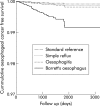Risk of oesophageal cancer in Barrett's oesophagus and gastro-oesophageal reflux
- PMID: 15247170
- PMCID: PMC1774141
- DOI: 10.1136/gut.2003.028076
Risk of oesophageal cancer in Barrett's oesophagus and gastro-oesophageal reflux
Abstract
Background and aims: While patients with Barrett's oesophagus develop oesophageal adenocarcinoma more frequently than the general population, it has controversially been suggested that gastro-oesophageal reflux (GORD) itself is a more important determinant of risk. In order to assess the validity of this suggestion, we examined the risk of oesophageal cancer in patients with Barrett's and with GORD compared with the general population in a community based cohort study.
Methods: Cohorts of patients with Barrett's (n = 1677), oesophagitis (n = 6392), and simple reflux (n = 6328), and a reference cohort (n = 13416) were selected from the General Practice Research Database. The last three cohorts were matched to the Barrett's cohort by general practitioner practice, age, and sex. Cox's regression analysis was used to calculate relative risks for oesophageal cancer. Standardised incidence ratio methodology was used to estimate the relative risks for oesophageal adenocarcinoma.
Results: A total of 137 oesophageal cancers were identified, of which 94 prevalent cases were excluded. The hazard ratios for oesophageal cancer were 10.6 (5.1-22.0), 2.2 (0.9-5.2), and 1.7 (0.7-4.5) in the Barrett's, oesophagitis, and reflux cohorts compared with the reference cohort, respectively. The corresponding relative risks for oesophageal adenocarcinoma were 29.8 (9.6-106), 4.5 (1.04-19.6), and 3.1 (0.6-14.2).
Conclusion: Barrett's oesophagus increases the risk of oesophageal cancer approximately 10 times and oesophageal adenocarcinoma approximately 30 times compared with the general population. There is only a modestly increased risk of oesophageal cancer in patients with reflux who have no record of Barrett's oesophagus. Our findings therefore do not support the suggestion that gastro-oesophageal reflux disease itself predisposes to cancer.
Figures
Comment in
-
Oesophageal cancer and gastro-oesophageal reflux: what is the relationship?Gut. 2004 Aug;53(8):1064-5. doi: 10.1136/gut.2003.038471. Gut. 2004. PMID: 15247167 Free PMC article. No abstract available.
References
-
- Spechler SJ, Robbins AH, Rubins HB, et al. Adenocarcinoma and Barrett’s esophagus. An overrated risk? Gastroenterology 1984;87:927–33. - PubMed
-
- Cameron AJ, Ott BJ, Payne WS. The incidence of adenocarcinoma in columnar-lined (Barrett’s) esophagus. N Engl J Med 1985;313:857–9. - PubMed
-
- Cooper BT, Barbezat GO. Barrett’s oesophagus: a clinical study of 52 patients. Q J Med 1987;62:97–108. - PubMed
-
- Achkar E , Carey W. The cost of surveillance for adenocarcinoma complicating Barrett’s esophagus. Am J Gastroenterol 1988;83:291–4. - PubMed
-
- Robertson CS, Mayberry JF, Nicholson DA, et al. Value of endoscopic surveillance in the detection of neoplastic change in Barrett’s oesophagus. Br J Surg 1988;75:760–3. - PubMed
Publication types
MeSH terms
LinkOut - more resources
Full Text Sources
Medical

